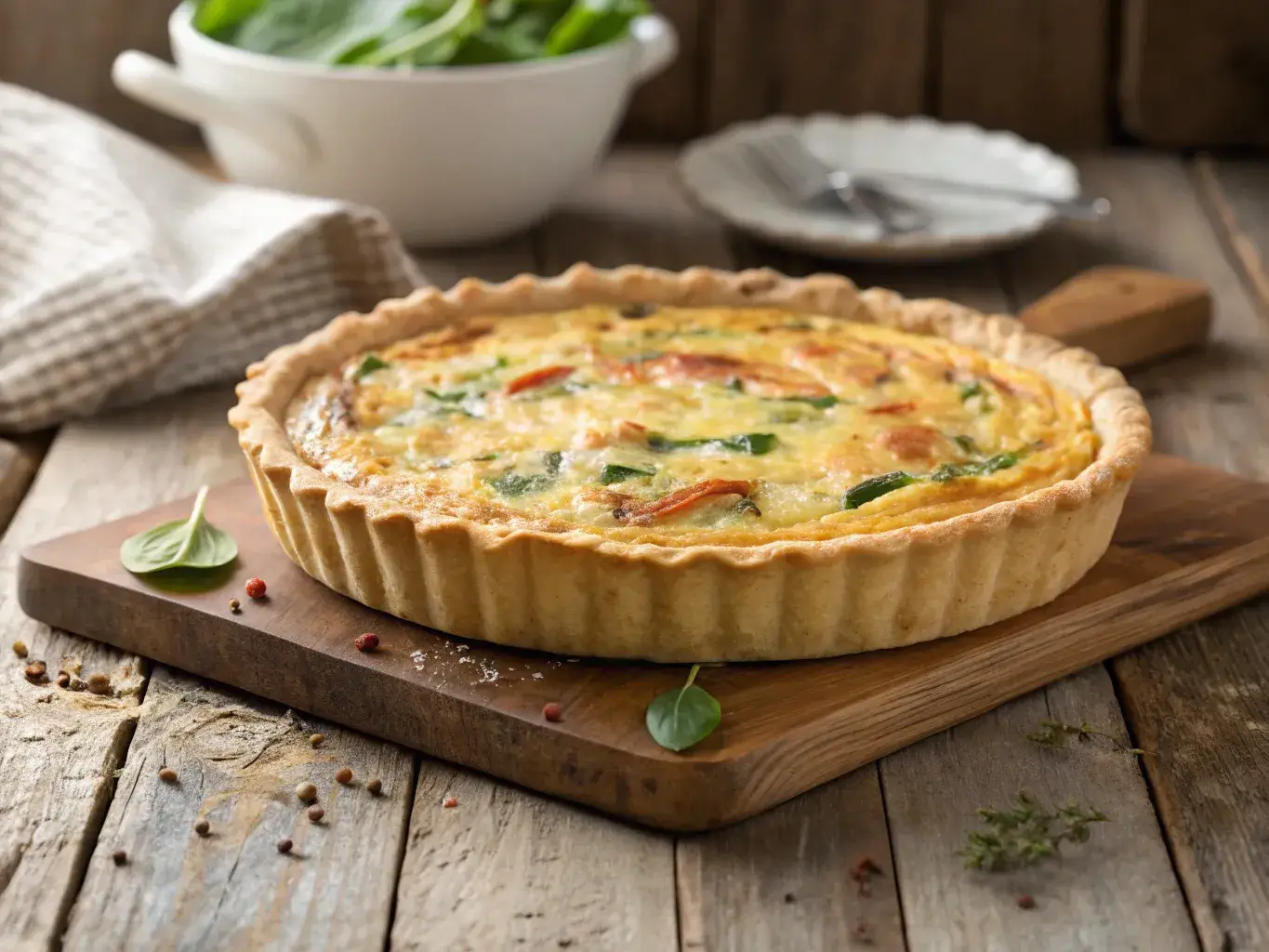Gluten free quiche proves that you don’t have to give up creamy, flavorful, and satisfying brunch favorites just because you’re skipping gluten. Whether you prefer it with a buttery, flaky crust or light and airy without one, this French-inspired classic can deliver the same savory magic.
In this ultimate guide to gluten free quiche, you’ll discover how to create the perfect crust, why parbaking is a game-changer, and how to avoid the dreaded soggy filling. We’ll also cover dairy-free swaps, freezer-friendly tips, and creative variations so you can keep your brunch menu fresh and exciting all year long.
Understanding Gluten Free Quiche Basics
What Is a Gluten Free Quiche?
A gluten free quiche is a savory baked dish made with eggs and milk or cream, typically filled with vegetables, cheese, and meats, but prepared without any wheat-based ingredients. This can mean using a gluten-free crust made from special flours like almond or rice flour, or skipping the crust altogether.
Unlike traditional quiche, which relies on a wheat-based pastry shell, gluten-free versions use alternative flours that are safe for those with celiac disease or gluten sensitivity.
Print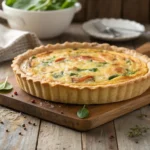
The Best Gluten Free Quiche Recipe: A Simple Guide to Crust or Crustless Perfection
- Total Time: 50 min
- Yield: 6 servings 1x
Description
A delicious and versatile gluten-free quiche with a buttery almond flour crust and a savory egg filling—perfect for breakfast, brunch, or a light dinner.
Ingredients
For the crust:
1 1/2 cups almond flour
1/4 tsp salt
1/4 tsp garlic powder (optional)
1/4 cup melted butter or olive oil
1 egg
For the filling:
5 large eggs
1/2 cup milk or dairy-free milk
1/2 cup shredded cheese (cheddar, Swiss, or goat cheese)
1/4 cup diced onion
1/2 cup chopped spinach or other veggies (mushrooms, peppers, etc.)
Salt and pepper to taste
Optional: chopped cooked bacon or sausage
Instructions
1. Preheat oven to 350°F (175°C).
2. In a bowl, mix almond flour, salt, garlic powder, melted butter, and egg until dough forms.
3. Press dough evenly into a greased 9-inch pie dish. Prick the bottom with a fork.
4. Bake crust for 10 minutes. Remove from oven and set aside.
5. In a medium bowl, whisk together eggs, milk, salt, and pepper.
6. Stir in cheese, onion, vegetables, and meat if using.
7. Pour filling into pre-baked crust and smooth the top.
8. Bake for 30–35 minutes, or until center is set and top is lightly golden.
9. Let cool for 5–10 minutes before slicing and serving.
Notes
Crust can be made ahead and frozen.
Use any combination of veggies or cheese for customization.
Store leftovers in the fridge up to 4 days or freeze individual slices.
- Prep Time: 15 min
- Cook Time: 35 min
- Category: Breakfast
- Method: Baking
- Cuisine: French
Nutrition
- Serving Size: 1 slice
- Calories: 260
- Sugar: 1g
- Sodium: 280mg
- Fat: 20g
- Saturated Fat: 7g
- Unsaturated Fat: 12g
- Trans Fat: 0g
- Carbohydrates: 6g
- Fiber: 2g
- Protein: 12g
- Cholesterol: 170mg
Keywords: gluten free quiche, almond flour crust, low carb quiche, easy breakfast bake
The goal? A custardy, tender center with enough structure to hold its shape, minus the gluten.
Why Choose Gluten Free Quiche Over Traditional?
There are plenty of reasons people choose gluten-free options, even if they’re not allergic. Some do it for better digestion, others to reduce inflammation, and many to follow a whole-food or clean-eating plan.
Here’s what sets gluten free quiche apart:
| Feature | Traditional Quiche | Gluten Free Quiche |
|---|---|---|
| Crust Base | Wheat flour | Gluten-free flour (e.g., almond, rice) |
| Digestion | May cause bloating for some | Easier on sensitive stomachs |
| Flexibility | Less allergen-friendly | Can be dairy-free, low-carb |
Common Myths About Gluten Free Quiche Baking Debunked
Let’s bust a few persistent myths:
- “Gluten free equals dry or tasteless.”
Not true. With the right egg-to-liquid ratio and cooking method, gluten free quiche is just as creamy and satisfying as the traditional kind. - “You always need fancy flour.”
While blends help, simple options like almond, oat, or even mashed potatoes (for crust) can work beautifully. - “Crustless quiche isn’t a real quiche.”
On the contrary, crustless quiche is a staple in many diets and is lighter, faster, and freezer-friendly.
Don’t miss our carrot cake cookies if you’re after a sweet, chewy gluten-free treat
Ingredients That Make or Break a Gluten Free Quiche
Creating a delicious gluten free quiche starts with understanding how each ingredient contributes to flavor, texture, and structure. Whether you’re going for a full crust or crustless style, the ingredients you choose will determine whether your quiche turns out fluffy, rich, or a soggy mess.
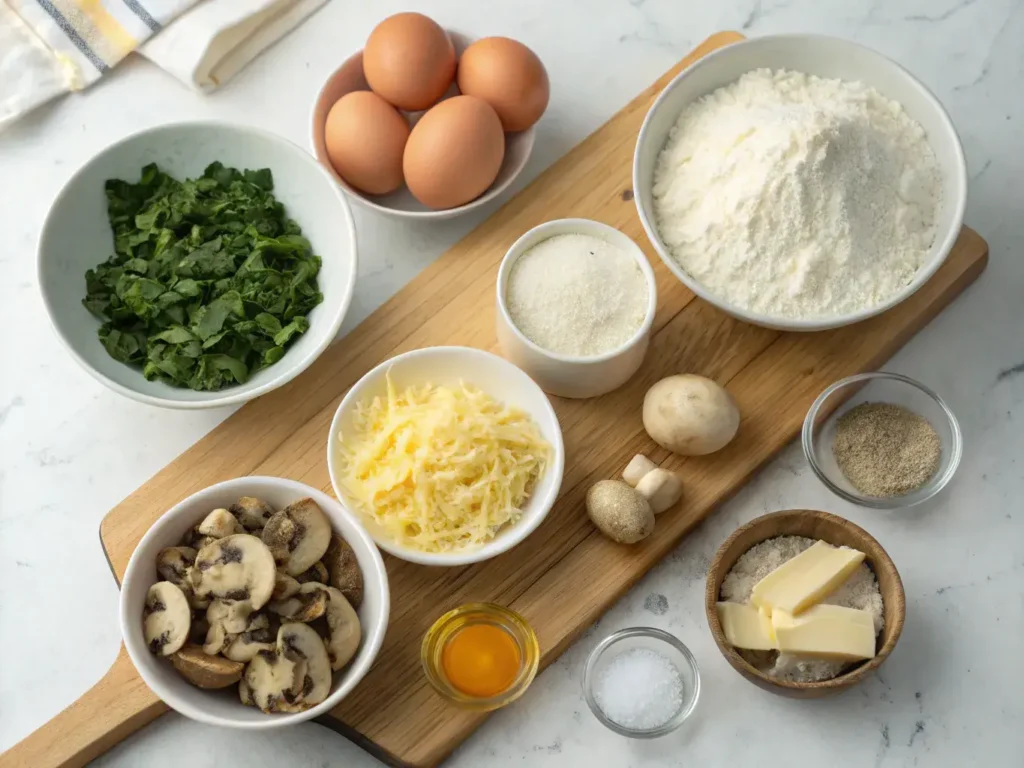
Let’s break down the most important components.
Choosing the Right Gluten Free Quiche Flour for Crusts
When making a crust, the flour is the foundation. Gluten provides elasticity in traditional crusts, so your gluten free flour mix needs to make up for that loss.
Best Gluten Free Flours for Quiche Crust:
- Almond flour: Great for nutty flavor and richness, but requires binding agents.
- Sorghum flour: Mild flavor and blends well with others.
- Brown rice flour: A neutral option with good texture.
- Tapioca starch or arrowroot: Adds chew and helps bind.
- Commercial blends (like Cup4Cup or Bob’s Red Mill): Reliable and ready-to-use.
Pro Tip: Choose a flour mix that contains xanthan gum or guar gum to help hold the crust together.
You can also experiment with crust alternatives like sweet potato mash or polenta bases for a creative spin on gluten free quiche.
Essential Dairy and Dairy-Free Alternatives
The classic quiche custard relies on half and half or whole milk to create that smooth, silky texture. But if you’re dairy-free or reducing fat, here are your go-to swaps:
| Traditional Ingredient | Dairy-Free Alternative |
|---|---|
| Whole milk | Unsweetened almond milk + coconut cream |
| Heavy cream | Cashew cream or oat cream |
| Butter (for crust) | Vegan butter like Miyoko’s or Earth Balance |
| Cheese | Violife, Daiya, or shredded oat-milk cheese |
Avoid using low-fat or fat-free dairy substitutes they don’t add the richness needed for a full-bodied custard.
Looking for inspiration? Try our carrot protein cake if you want another protein-rich, dairy-optional dish.
Eggs, Seasonings, and Moisture Control
The egg is the heart of a quiche. The golden rule is: 1 egg per 1/4 cup of milk or cream.
This ratio ensures the filling sets without curdling or becoming rubbery. Use fresh, room-temperature eggs for better blending.
Seasonings That Boost Flavor:
- Salt and black pepper (classic)
- Nutmeg (for subtle warmth)
- Garlic powder or onion flakes
- Dried thyme, parsley, or smoked paprika
Moisture is your biggest enemy in quiche. If using vegetables like mushrooms, spinach, or zucchini, always cook them first to remove excess water.
Summary of Must-Have Ingredients for a Gluten Free Quiche:
| Category | Ingredients |
|---|---|
| Base | Gluten free flour, cold butter, xanthan gum |
| Custard | Eggs, milk or cream, salt, spices |
| Vegetables | Cooked mushrooms, spinach, onions |
| Cheese | Gruyère, cheddar, or dairy-free options |
| Optional Meats | Bacon, ham, turkey sausage |
Don’t miss our rock bottom pie if you’re craving something rich and gluten-free for dessert.
How to Make a Gluten Free Quiche Crust
A flaky, golden crust is the crown of a good quiche but when you’re baking gluten free, it can also be the biggest challenge. Without gluten’s natural elasticity and stretch, it’s easy for crusts to crack, crumble, or bake unevenly.
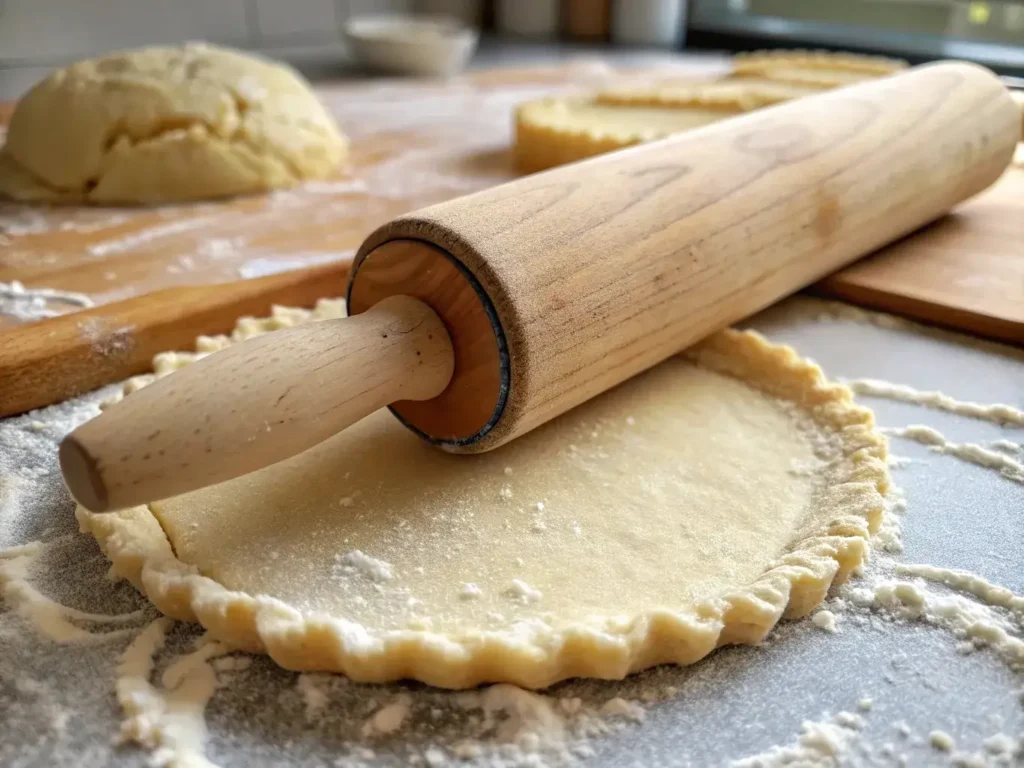
Here’s how to master a gluten free quiche crust that’s buttery, tender, and never soggy.
Step-by-Step Crust Preparation with Cold Butter Technique
The key to a great crust lies in cold fat and a gentle hand. Cold butter creates steam when it melts in the oven, forming delicate, flaky layers.
How to Prepare a Gluten Free Quiche Crust:
- Start Cold: Chill your butter, water, and even the flour for 20 minutes before mixing.
- Combine Dry Ingredients:
- 2 cups gluten free all-purpose flour
- 1 tsp xanthan gum (if not included in the mix)
- ½ tsp salt
- Add Fat:
- Cut in 8 tbsp chilled butter using a pastry cutter or your fingers until it looks like coarse crumbs.
- Add Ice Water Slowly:
- Add ¼ cup at a time and mix gently. Stop when the dough holds together but isn’t sticky.
- Form a Disk & Chill:
- Wrap in plastic and refrigerate for at least 30 minutes.
Pro Tip: For extra flakiness, roll out the dough, fold it into thirds, then roll again before chilling.
When and How to Parbake the Crust for Flaky Results
Parbaking (partial baking) is non-negotiable when working with wet fillings like quiche. It prevents the crust from getting soggy and ensures it holds its shape.
Parbaking Instructions:
- Preheat oven to 425°F (220°C).
- Roll out the dough and fit into a greased 9-inch pie plate.
- Prick the base with a fork to prevent bubbling.
- Line with parchment and add pie weights (or dried beans).
- Bake for 15 minutes until lightly golden.
- Remove weights and parchment; cool before adding filling.
Skipping this step? Your bottom crust will likely turn gummy or undercooked.
Gluten-Free Pie Crust Troubleshooting Tips
Making your first gluten free pie crust? These common issues might come up and here’s how to solve them:
| Problem | Cause | Solution |
|---|---|---|
| Dough too crumbly | Not enough water or overmixed | Add water 1 tsp at a time |
| Crust shrinks during baking | No chilling or overworked dough | Chill before baking |
| Crust cracks or tears | Too dry or rolled too thin | Patch with extra dough or re-roll |
| Bottom too soggy | No parbake or filling too wet | Parbake and pre-cook veggies |
Looking for a dessert idea with no crust drama? Try our carrot cake cookies for a chewy, gluten-free treat.
Making a Crustless Gluten Free Quiche
Not in the mood to roll out dough? Looking to cut carbs or save time? A crustless gluten free quiche might be your new go-to. This option skips the pastry base entirely, delivering a rich, creamy center with far less prep.
And the best part? No compromise on flavor.
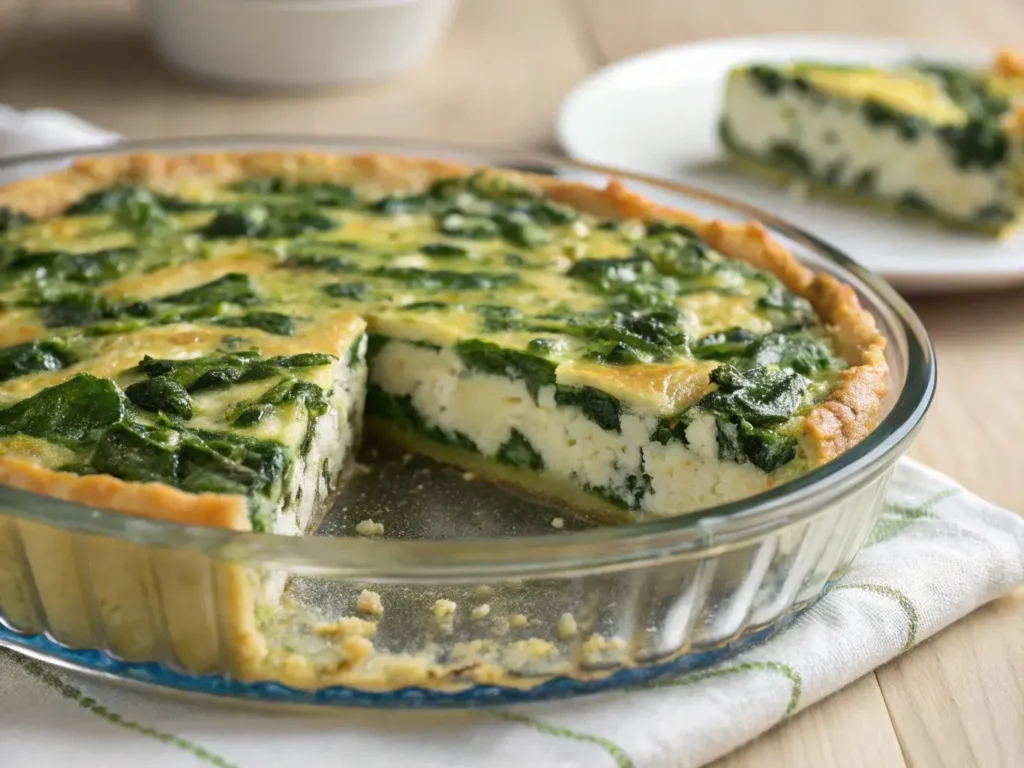
Benefits of Going Crustless for Quiche
A crustless quiche isn’t just a lazy workaround it’s a smarter, lighter choice for many people.
Here’s why:
| Benefit | Why It Matters |
|---|---|
| Faster prep | No chilling, rolling, or parbaking needed |
| Lower carb | Great for keto, paleo, and diabetic diets |
| Fewer allergens | Perfect for gluten-free and grain-free diets |
| More filling per bite | No crust = more room for veggies and cheese |
Want another low-fuss recipe? Check out our carrot protein cake—a healthy treat that requires no fancy ingredients.
Best Bakeware for Crustless Options
Unlike crusted quiches, which require pie plates, crustless quiches give you flexibility in bakeware.
Recommended Options:
- Ceramic pie dish (9-inch): Holds shape and distributes heat evenly.
- Glass baking dish (8×8 or 9×9): Easy to monitor doneness.
- Muffin tins: Great for individual servings and meal prep.
- Cast iron skillet: For a rustic, crispy-edged finish.
Always grease your dish well (use butter or oil spray) to prevent sticking since there’s no crust barrier.
How to Prevent a Soggy Bottom Without a Crust
Without a crust to soak up moisture, it’s critical to control the wetness of your filling. Follow these steps for a solid, sliceable result:
- Cook all vegetables before adding to the mix, especially mushrooms, spinach, zucchini, and tomatoes.
- Drain excess water from cooked veggies using paper towels or a fine mesh sieve.
- Use the correct egg-to-dairy ratio:
- For every 1 egg, use ¼ cup of milk or ⅓ cup of half-and-half.
- Let the quiche rest for at least 15 minutes after baking. This sets the custard and avoids crumbling.
Crafting the Perfect Filling Gluten Free Quiche
If the crust is the frame, the filling is the masterpiece—and when it comes to quiche, your filling must strike a delicate balance between creamy, flavorful, and firm. Too wet, and it’s mushy. Too dry, and it turns rubbery.
Here’s how to master the gluten free quiche filling every time.
Egg to Cream Ratio Explained for Creamy Texture
At the heart of any quiche is a custard made from eggs and cream (or milk). Get the ratio right, and your quiche will be silky, rich, and slice cleanly.
The Golden Ratio:
- 1 large egg per ¼ cup milk
or - 1 large egg per ⅓ cup half-and-half (for a richer texture)
Use 4–6 eggs for a standard 9-inch quiche, depending on how tall you want it.
Pro Tip: Whisk the eggs and cream thoroughly to prevent pockets of egg white or uneven cooking.
Cooking Vegetables Before Baking: Why It Matters
Most vegetables release water as they cook. If you throw them into your filling raw, that moisture ends up in your quiche—resulting in a soggy, unstable center.
Always Cook These First:
- Mushrooms – sauté until browned and dry
- Spinach – steam, then press with paper towels
- Zucchini – roast or grill to evaporate moisture
- Onions, Peppers – sauté for sweeter, softer texture
Pre-cooking enhances flavor, softens the texture, and keeps your quiche firm.
Looking for inspiration? Try our carrot cake cookies for a spiced, gluten-free sidekick to your savory brunch spread.
Cheese Options and Swaps for Lactose-Free Diets
Cheese is more than just flavor it helps bind your filling and adds richness. But not all cheeses behave the same.
Best Cheeses for Quiche:
- Gruyère classic, melts well, nutty taste
- Cheddar sharp, accessible, family-friendly
- Goat cheese tangy and creamy, pairs well with greens
- Feta crumbly, salty, excellent in Mediterranean-style quiches
Dairy-Free Swaps:
- Violife Mozzarella-Style Shreds
- Miyoko’s Farmhouse Cheddar
- Daiya Cutting Board Collection
Avoid high-moisture cheeses like fresh mozzarella unless you drain and pat them dry.
Assembling the Filling Like a Pro
Here’s the layering order for a balanced gluten free quiche:
- Grated Cheese (half) on the bottom of crust or pan
- Cooked Veggies & Protein evenly distributed
- Remaining Cheese adds richness to the top
- Egg-Cream Mixture poured slowly over everything
Bake at 350°F for 30–40 minutes or until the center is just set and jiggles slightly.
Baking Your Gluten Free Quiche to Perfection
Oven Temperatures and Timings That Work
Getting the bake just right is crucial for quiche. Overbake it, and you’ll get rubbery eggs. Undercook it, and it’ll fall apart when sliced.
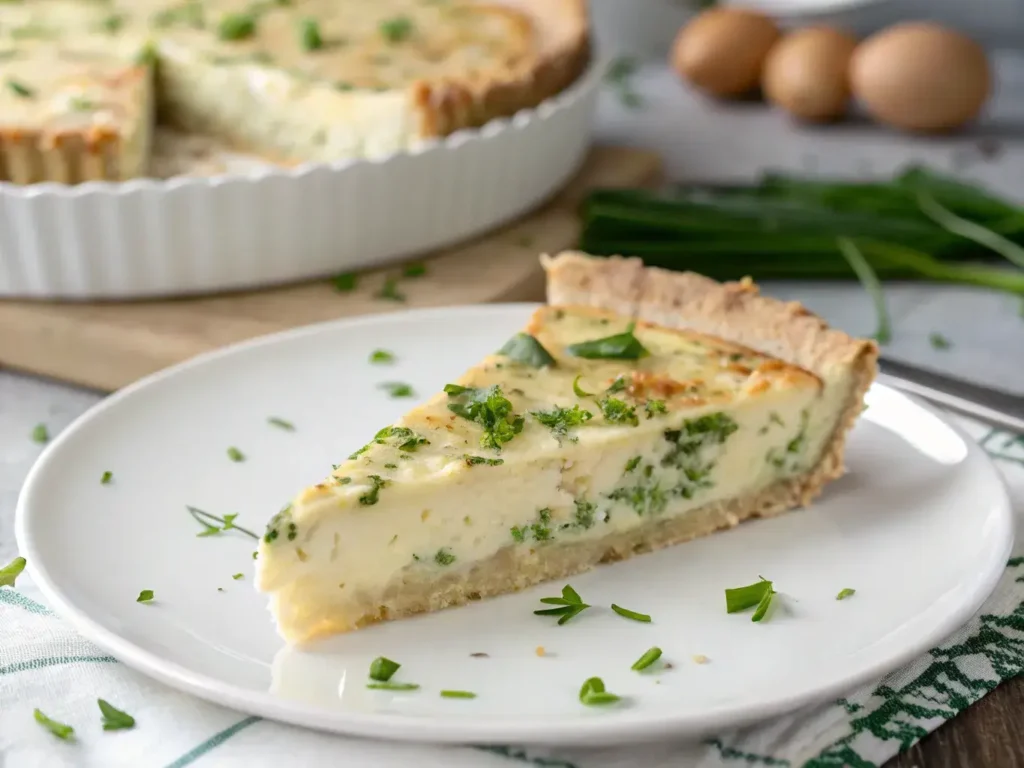
The Sweet Spot:
- Bake at 350°F (175°C)
- 30 to 40 minutes for standard quiche
- Reduce time to 20–25 minutes for crustless or muffin tin versions
Tip: Cover the edges of the crust with foil if they brown too fast before the center sets.
How to Tell If Your Quiche Is Fully Baked
Forget poking with a knife, here’s how to tell if your quiche is perfectly cooked:
- The edges should be golden and puffed.
- The center should jiggle slightly when you gently shake the pan.
- Insert a toothpick 1 inch from the center. It should come out moist but not wet.
Let it rest for 15–20 minutes before slicing to help the custard set.
Resting and Cooling Tips Before Serving
Serving quiche right out of the oven might sound cozy, but it’s not ideal.
Why Resting Matters:
- Prevents runny slices
- Improves texture
- Flavors meld during the cooling process
Cover loosely with foil and let it sit on the counter. Want to serve it warm? Reheat gently in a 200°F oven for 10 minutes.
Variations and Ingredient Ideas Gluten Free Quiche
Popular Gluten Free Quiche Combinations
Mix and match flavors to suit any mood or season.
| Combo | Ingredients |
|---|---|
| Classic Lorraine | Bacon, Gruyère, caramelized onion |
| Mediterranean | Spinach, feta, sun-dried tomato |
| Garden Veggie | Bell pepper, mushroom, broccoli |
| Southwest | Chorizo, cheddar, jalapeño |
Add pre-cooked proteins like shredded chicken, turkey sausage, or tofu crumbles for extra heartiness.
Seasonal Vegetable Add-ins for Year-Round Cooking
| Season | Best Veggies |
|---|---|
| Spring | Asparagus, green onions, peas |
| Summer | Zucchini, corn, cherry tomatoes |
| Fall | Butternut squash, kale, leeks |
| Winter | Mushrooms, broccoli, caramelized onions |
Always cook or blanch before adding to prevent excess moisture.
Kid-Friendly and High-Protein Options
Make it family-approved or fitness-friendly:
- Use muffin tins for mini quiches perfect lunchbox bites!
- Add cottage cheese for a protein boost
- Skip spicy ingredients and stick to simple combos: ham + cheddar, or spinach + mozzarella
Don’t miss our carrot protein cake if you want another protein-rich gluten-free recipe.
Storage, Freezing, and Reheating
Best Practices to Store Gluten Free Quiche
- Fridge: Store in an airtight container for up to 4 days
- Freezer: Wrap slices individually and freeze for up to 3 months
Label your quiche with the date and reheat instructions for easy access.
How to Freeze and Reheat Without Losing Texture
- Let quiche cool completely.
- Wrap tightly in plastic wrap, then foil.
- For crustless, place in a freezer-safe container.
Reheating:
- From fridge: 200°F oven for 15 minutes
- From freezer: Thaw overnight, then reheat at 325°F for 25 minutes
Avoid microwaving, as it can make the eggs rubbery and crust soggy.
Serving Suggestions for Leftovers
- Pair with a fresh green salad
- Serve with gluten-free toast or biscuits
- Add hot sauce or avocado for a twist
FAQs – Answering Your Top Questions About Gluten Free Quiche
How do I know when my gluten free quiche is done baking?
The center should have a gentle jiggle, not slosh. A toothpick inserted near the center should come out clean. Let it rest before slicing.
Can you make this gluten free quiche without a crust?
Yes! Crustless quiche is lighter, faster, and just as delicious. Just grease the pan and follow the same steps—no crust needed.
What happens if I don’t parbake my pie crust before filling it?
The crust will likely turn soggy and underbaked. Parbaking ensures a flaky base even after adding a wet filling.
Do I have to cook the vegetables first?
Yes. Cooking the vegetables helps remove moisture, preventing a watery, unstable filling.
Can I use other vegetables in the filling?
Absolutely! Feel free to add seasonal veggies like asparagus, squash, or kale. Just make sure they’re cooked or blanched first.
Is gluten free quiche freezer friendly?
Yes! Let it cool completely, then wrap and freeze for up to 3 months. Thaw overnight before reheating for best results.
Mastering the Art of Gluten Free Quiche
Whether you’re a brunch aficionado, meal prepper, or simply avoiding gluten for health reasons, mastering the art of gluten free quiche gives you a versatile, crowd-pleasing dish you can enjoy anytime. With the right crust (or no crust), proper egg-to-cream ratio, cooked veggies, and flavor combos, this dish becomes both comforting and elegant.
From crusted to crustless, from classic to creative, gluten free quiche proves that dietary restrictions don’t mean sacrificing taste or texture.

